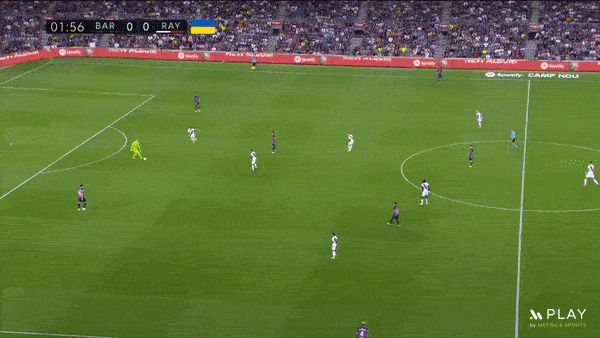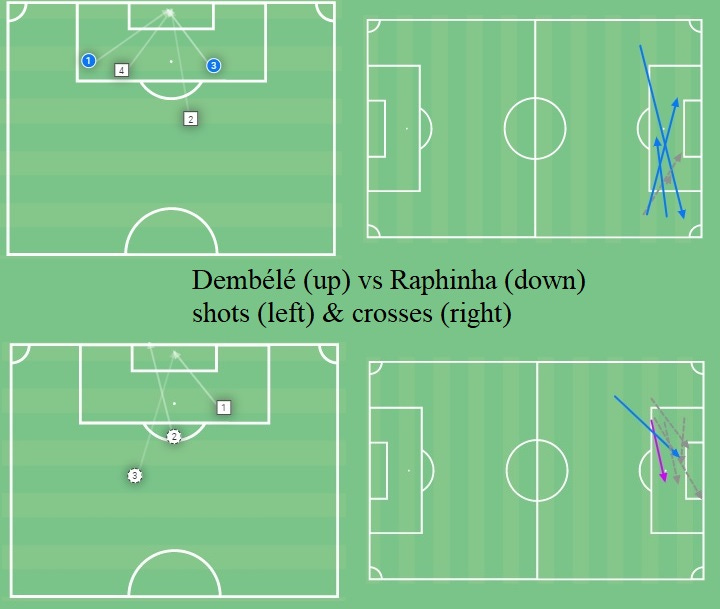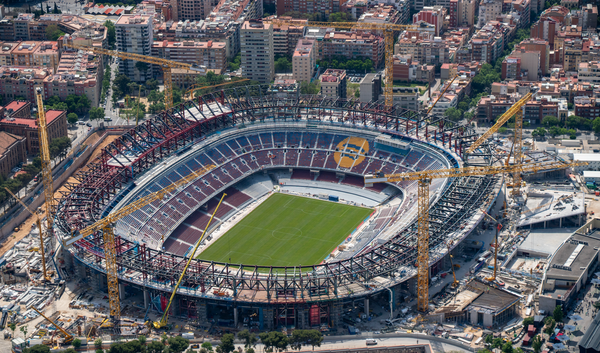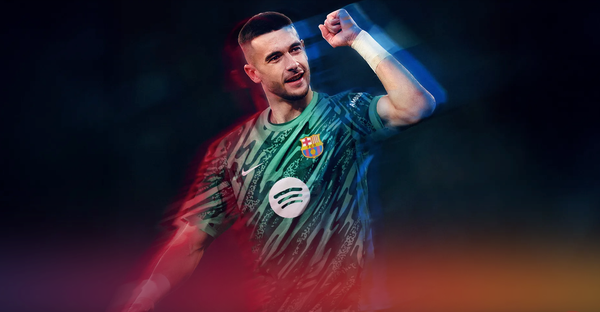Xavi's wide conundrum & the Raphinha-Dembélé experiment
The Frenchman is far more effective on the right while Raphinha turns into a creator on the left, but maybe there is a case for him to be a more central player

It’s quite interesting - and impressive - that Barcelona haven't lost their LaLiga opener at the Camp Nou since 1939. That’s over 80 years of draws and victories to start the season with (some) wind in their sails. Again, impressive. But any serious title challenger wouldn’t and shouldn’t be satisfied with a point in any game, let alone the very first one that also happens to be on home soil. While a draw against Rayo Vallecano in particular is a step in the right direction as of late, considering Barça had lost their last two bouts with the lads from Vallecas before Saturday’s draw, the point still feels… insufficient. Disappointing. Or perhaps, in some way, even cruel?
Alas, it’s all they got and Rayo deservedly left back to Madrid with at least some spoils of war. However, despite the slow start to the campaign, Xavi will have (hopefully) finished the game at least a bit wiser. Mistakes and experiments can often backfire, costing you goals or even games. Barça’s experiments yielded some results but ultimately proved not to be enough to get all three points. While you could argue Ronald Araújo manning the right-back position is an experiment on its own, as is the somewhat surprising centre-back partnership of Eric García and the newcomer Andreas Christensen, it’s the one in the wide areas and further up the pitch that piqued my interest much more.
You see, Raphinha, Barcelona’s big summer signing, is largely seen as Ousmane Dembélé’s second; an additional elite rotational option to give both depth and quality to a team - and position - that sorely needs it. However, there was always an option that both could start at the same time - one manning the left whilst the other occupies the right. After all, Raphinha is left-footed so could theoretically be used as a wide(-ish) option on the left while Dembélé is ambipedal and apparently doesn’t have a preference at all. Or does he?
As much as there is logic behind both players playing in the same XI, their first outing left a lot to be desired. So why did Xavi opt for it and how did it - or should I say, how was it supposed to pan out? Finally, how did it affect the team and the individuals within it?
Let’s dive straight into it.
The initial blueprint
‘Raphinha has characteristics that Neymar and Rivaldo had. He has a lot of talent and is a difference maker,’ Xavi said of his new lucrative acquisition, comparing him to some of Barcelona’s prodigious Brazilians that donned the Blaugrana shirt before him. It’s a tall order emulating Neymar and Rivaldo of all people, let alone combining the best traits of them both. But Saturday’s disappointment, while certainly tainted by individual mishaps, wasn’t predicated on it. At least not in its entirety.
Yes, a calmer finish by Dembélé when facing the now notorious Stole Dimitrievski could’ve made the difference. The same with Raphinha’s shooting boots from outside the box, which weren’t draped in their usual venom. However, it felt like the setup had been sub-optimal from the very start despite some logic behind it.
Before criticising something that may or may not work, I first try and understand it. Xavi deployed Raphinha and Dembélé at the same time in pre-season and it yielded decent results so there was no real reason to immediately abandon the blueprint. It does make sense when you think about it — Raphinha is the better goal-scorer between the two while Dembélé is the Brazilian’s superior in chance creation and unpredictability. Both prefer the right flank but can, on occasion, be deployed on the opposite end of the pitch too.
Considering Dembélé’s ambipedal nature, I can see Xavi’s thinking when he decided to use the Frenchman on the left, hoping it wouldn’t limit him too much. In that scenario, on paper at least, Dembélé would retain his elite creativity while Barcelona could still reap the benefits of Raphinha’s lethality by giving him his preferred right-winger role. In a perfect world, you get the best out of both wingers and their strengths come together in a crescendo of goals galore. Only football is anything but controlled perfection. Even madmen like Pep Guardiola can attest the chaos of the sport is sometimes impossible to contain and the pre-game tactical boards are often nothing more than vague predictions of what may transpire on the pitch.
Of course, that is not to say this particular setup has no future. After all, we’ve already seen it work, albeit in much less competitive scenarios before the season’s official start. Below, I’ve used Wyscout’s database to extract both Raphinha and Dembélé’s action maps from the Rayo clash.

Raphinha spent the first half an hour on the right while Dembélé occupied the left and then, between minutes 30 and 60, the latter mark being the moment the Brazilian was replaced by Ansu Fati, they swapped places. The action maps above do a good job telling us how successful the tandem was in their respectful positions, highlighting some interesting and surprising conclusions. The expected outcome concerns Dembélé as the Frenchman did a much better job ‘being himself’ on the right, as is usually the case. Raphinha, however, seemed to struggle to break down Rayo’s left side despite playing in his preferred inverted right-winger role.
More than half of his attempts ended in failure as the Brazilian found no luck cutting into the right half-space. Intriguingly, on the other hand, the left seemed to be more down his alley. While playing on the right side, Raphinha registered 0.15 xG and completed 11/27 of his overall actions, only enough for a 41% realisation rate. That was followed up by two shots, neither of which were on target, one successful dribble out of three in total, zero crosses and 0.01 xA. In short, nothing to write home about.
The only positive is the expected goals value, which is decent, albeit not exactly spectacular. But that was the whole point of the initial setup — Dembélé was there to create danger while Raphinha was supposed to materialise it into goals, hence the surge in xG. The right side of the pitch was meant to put the Brazilian in an optimal position to threaten the goal directly and ultimately, rattle the inside of the net. How exactly? Let’s explore the setup from minutes 1-30 a bit more.

I’ve highlighted our two wingers and Jordi Alba in this image. The reason behind it is that Alba was among the players most affected by the choice of his accompanying winger and as a result, the left-back/left-winger tandem and its (un)successful attempts at breaking down Rayo’s block played a big role in the final result. Dembélé’s proficiency with both feet meant he was comfortable cutting inside and occupying the left half-space, giving Alba more freedom to join up the attack. With the addition of a high interior on the other side accompanying the far side touchline-hugging winger and centrally-positioned striker in Robert Lewandowski, Barcelona would, in theory, occupy all five lanes in the attacking phase.
This is the first difference between the two wingers - Dembélé in the half-space, allowing for the overlap and Raphinha hugging the touchline, keeping Araujo, the right-back, just behind him as support. The other distinction is the one we’ve already mentioned — Dembélé as the creator (with Alba as the secondary option), Raphinha as the goal-scorer. With Dembélé and Alba compatible on paper, Xavi intended either to feed passes into Lewandowski or Raphinha, aiming to find the former due to his elite movement inside the box and isolate the latter, making use of his delayed inversion from the wide areas.
‘We struggle with interior play. We already do well on the wings, but we need to combine more in the middle. The idea is to do it with the third man. We did it well a couple of times, but there are things that we have to adjust,’ said the coach after the game, giving us a taste of the game plan — the third man.

We know the now-famous quote that the ‘third man is impossible to defend’ and when executed well, I truly believe it lives up to that description. Interestingly, within the first couple of minutes of the game, you could see Barcelona sticking to the blueprint and actually effectively executing it. The GIF above shows how Sergio Busquets succeeded in ejecting Alba into space after a great combination play that not only created space and dynamic superiority for the hosts but also freed up the distributor in the process as well. Beautiful and - more importantly - impossible to defend.
As a result, the Catalans get a 5v5 situation in the opposition’s half and have one of their primary goal-scoring threats completely isolated on the opposite flank. The attack is foiled only by Alba’s unfortunate failed attempt at a cross, as the pacey Spaniard only managed to get it as far as the first - and only - defender engaging in a block. Still, the intention was very clear and when executed well, it also worked. But to my, and I’m sure many others’, disappointment, that was practically the only such sequence in the whole 90 minutes of that deflating draw at the Camp Nou.
Part of the reason was that neither Raphinha, Dembélé or Alba had particularly stellar performances. On the left, the Frenchman managed to complete only 37% of his actions, registering one successful cross which was also the only one he attempted and one shot assist for a grand total of 0.06 xA in the first 30 minutes of the game. Clearly, despite his ‘comfort’ on both sides, the left did not treat Dembouz kindly. He didn’t fare any better in the goal-scoring role either, slugging away to zero shots and zero xG; disappointing to say the least. But how did that affect Alba?

The initial setup was meant to get the best out of both players, allowing Dembélé to create from the half-space, show for the ball and Alba to overlap and deploy crosses and cutbacks. However, both players failed to live up to the expectations. We’ve already seen Dembélé’s numbers and sadly, Alba didn’t fare any better at all. In the opening 30 minutes of the bout, he completed a respectable 78% of his 23 actions and 80% of his 20 passes but then failed to materialise it into anything, totalling one inaccurate cross, two progressive runs, zero shot assists and zero xA. Truly a far cry from the player who averaged 0.2 xA, 4.62 crosses and 1.53 shot assists per 90 minutes last season.
Considering he was set up for a more successive night, this is quite disappointing and perhaps even discouraging moving forward. When I say this setup was designed to get the best out of them, I mean the structure looked to play to their skill sets. Dembélé would start most attacks in the half-space, as we saw in one of the previous images, with Alba ready to overlap. Still, wingers in Xavi’s system have clear instructions to hold the width and stretch the pitch, at least initially. So Dembélé did just that as soon as the ball started rolling from the backline.
With García, Barcelona’s most progressive option, marauding forward, the French winger would initially drift outward from his half-space position, attempting to create space horizontally between the opposition’s last line of defence. As soon as the ball edges closer to him, however, Dembélé wants the ball to feet and moves towards it.

We saw a similar thing in the third-man video and we see the same here. Dembélé receives to feet and frees up the space for Alba to overlap while Raphinha is the one getting isolated on the far end as a result. The same would happen if the midfielders were in possession; Dembélé starts wide but then cuts inside, only in that scenario, he will attempt a run beyond the opposition’s backline, hoping for a lobbed pass to find his long stride. Again, him inverting means Alba is free to join the attack down the left flank, as he usually does.
However, despite their complementary nature, the duo didn’t perform in their respective roles and the same can be said for Raphinha on the opposite end who, despite the highest xG between the trio and admirable work rate, was similarly bleak when everything is said and done. In that same period, Barcelona as a team registered 0.2 xG and attempted four shots with only one hitting the target.
By minute 30, Xavi had seen enough. It was time for a change.
The swap
From minutes 31 until 60, Dembélé and Raphinha were still on the pitch together, only now, the Frenchman was back on the right flank while the Brazilian was ‘relegated’ to the left. This seems like a small tweak but it changed a lot in terms of their profiles and how they interacted with the rest of the team. Dembélé was still the creator but now, Raphinha was one too. When playing on the right, the ex-Leeds United star is primarily a goal-scorer, as was already established earlier in this piece.
Having him positioned on that flank with the freedom to cut in is the perfect scenario for a left-footed attempt at goal, which is what Raphinha often does and did against Rayo as well. On the left, however, despite still wanting to invert, his left foot becomes a tool for crossing more so than shooting. We can see the same below.

You can see that his two shots from open play came from the right cutting in while the third one from distance was the only one post the 30th minute. Similarly, while playing on the right, Raphinha had attempted no crosses whatsoever, focusing more on the goal-scoring instead. However, as soon as the switch happened, so did the change in his role, which is closely connected to his heavy left-footedness. As a result, all six of his crosses came from the left flank, two of which were successful and one was even registered as a key pass.
The statistics also confirm this thesis. Between minutes 31-60, Raphinha registered 0.08 xA compared to 0.01 xA on the right, attempted six crosses to zero on the right and finally, had one shot fewer as well. All of this indicates his role had been slightly tweaked to a more creator-based one. Now, the Brazilian was tasked with finding Lewandowski in the box, preferably via crosses.
For Dembélé, on the other hand, not much had changed — he was still the leading creator but this time, playing on his preferred side, he was much more comfortable, deploying more attempts and seeing a rise in numbers too. Dembouz completed 58% of his 24 actions between minutes 31-60, registered 0.07 xA and even tallied 0.11 xG. It has to be noted, however, that his xA numbers rose significantly as the game went on, already reaching 0.26 by minute 75. Quite clearly, despite being ‘comfortable’ on both flanks, Dembélé still had a preference after all.
But what about the general setup in that period? Let’s check it out below.

As far as the rest of the team is concerned, not much had changed. The shape is mostly the same but now, the left winger is hugging the touchline (initially) while the right winger is more of a half-space occupier (but will still stretch the pitch in certain scenarios). With Raphinha ahead of him, Alba doesn’t go as far forward as he did with Dembélé and with no half-space presence for the five-lane attack, Pedri is tasked to push higher up the pitch too.
And it’s Pedri who then had a big role to play in Barcelona’s attacks to come. With Dembélé on the other end, the midfielders and the centre-backs would regularly look for Pedri instead. The young starlet in the left half-space was in a great position to both progress play and create, deploying passes to Lewandowski and Raphinha. The sequence would look something like the image below.

You can see the high positioning of Pedri and how he receives in the half-space, something that wasn’t entirely possible with Dembélé occupying that spot in the first half an hour of the game. Another important distinction is the fact Raphinha is more of an outlet than his French counterpart, meaning his off-the-ball movement is different. Lewandowski himself doesn’t exactly offer runs in behind the opposition’s line as much but can and does to an extent.
This gives Pedri at least two targets to aim for once he finds himself in possession around this exact area and moving forward. However, once again we come back to the third man runs. Despite Lewandowski not being the strongest outlet Barça have, his combinatory traits are excellent. In the initial setup, I felt this specific tool was underutilised and was also partly why the Catalans couldn’t establish a dominant position in the middle of the park.
Lewandowski just wasn’t involved enough nor did Barça use him to create those essential overloads Xavi keeps mentioning in almost every press conference. However, as time went on, we started to see some resemblance of a plan emerging once again. More can be seen in the GIF below.

This particular sequence demonstrates a couple of things we’ve just established. Firstly, as soon as Eric is in space and progressing, Raphinha starts to make a darting run beyond the opposition’s line. This in itself differs from the way Dembélé operates; while he can act as an outlet, his first instinct is to ask for the ball to feet in a more inverted position in the half-space. Secondly, with Raphinha hugging the touchline, it’s Pedri who’s positioned high in the left half-space. It’s also he who makes the run through it. Thirdly, we have Lewandowski dropping and ejecting the runner into space — even though Raphinha was the better (and easier) target, the Pole tried accessing Pedri, partly, perhaps, due to the ball falling to his weaker left foot, robbing him of more control and precision. Finally, we have to note the positioning of Alba, who, now, with a proper wide winger ahead of him, is ‘relegated’ to a much deeper role.
As opposed to the sequence in the first GIF example, it’s Raphinha making the run down the left flank and not the pacey full-back. So how exactly did having the Brazilian ahead of him impact Alba and his performance?

If we compare Alba’s heatmap from minutes 31-60 to the one from minutes 1-30, we can see a couple of clear distinctions. Due to Raphinha’s wide initial positioning, Alba is deeper than was the case with Dembélé. Yes, in both cases there’s a lot of activity just around the entrance to the opposition’s half but with Raphinha, Alba didn’t go as far forward out wide nor did he stay there for long. Interestingly, however, he would invert a lot more, even reaching the box at times, which wasn’t the case in the initial example.
Statistically, however, it didn’t make much of a difference. Between minutes 31 and 60, he registered zero crosses, zero xA, one progressive run and one successful dribble, which was also the only one attempted. Intriguingly, having completed 83% of his 35 actions and 86% of his 21 passes, he was more successful in that regard than in the first half an hour of the game played at the Camp Nou. But considering it was a more subdued role in the first place, that does make sense to an extent.
In that period, Barcelona as a team went from 0.2 xG to 0.27, attempted five shots compared to four, albeit again with only one hitting the target, and somewhat maintained the same level of ball possession. However, their tempo had changed a lot. With the wingers swapped, match tempo (Per Wyscout, number of passes per minute of possession) went from 17.06 to 15.66 and they registered 4.17 passes per possession compared to the 6.7 from the first 30 minutes. This means attacks were shorter and there were fewer passes per minute of possession.
None of it, however, mattered too much. Try as they might, Barcelona still couldn’t create a lot. Enter Fati, Xavi’s ace up the sleeve.
Final swap & conclusion
From the 60th minute onward, Fati was the Catalans’ left-winger and Raphinha’s night was done and dusted. The Brazilian’s performance certainly wasn’t bad but sadly, it also wasn’t enough to get the job done. Of course, going by that same logic, neither was Fati’s as Barcelona still couldn’t score even with him on the pitch. However, the difference in generated threat shouldn’t be ignored.
Let’s start with movement, positioning and relationships with teammates. Below is Fati’s heatmap compared to Alba’s between minutes 60 and 90 (Alba exited the pitch around the 89th minute).

Quite clearly, Fati’s role is much more aggressive compared to either of the other two wingers; he pushes up forward, attacks the box and is also far more free in his movement, even swapping sides and positioning himself centrally. This movement had also freed Alba, albeit, sadly, with no significant improvements in the output — his xG and xA values still remain firmly at zero and the crosses weren’t more frequent than before.
But it wasn’t just Alba this change affected; it was the entirety of the frontline, including Lewandowski, who was now more free due to Fati’s extreme gravity and Dembélé had one more lethal teammate to look for in the box. The young no.10 registered 0.26 xG between minutes 60-90, topping Raphinha’s total of 0.16 in half the time.
Collectively, too, Barcelona shined more, skyrocketing to 1.26 xG, 10 shots (three on target) and 4.44 passes per minute of possession, maintaining that quicker style of attacking. Ultimately, of course, it didn’t matter as Rayo wouldn’t be breached that night but Xavi had hopefully still left the pitch wiser than he was before.
I wouldn’t say the initial setup that sees Raphinha manning the left and Dembélé on the right should be scrapped entirely. However, the Frenchman is far more effective on the right while Raphinha turns into a creator on the left. And considering the Brazilian’s chance creation, while not bad, isn’t as elite, and that his movement blocks Alba, there is an argument for abandoning the approach. Or at the very least leave it as a situational option. Not to mention that with Dembélé on the left, which would be the result of ‘sacrificing’ him to accommodate Raphinha on the right, Pedri isn’t as aggressive as he can be.
All of this gains even more prominence considering how impactful Fati can be. This, of course, depends on his fitness. To put it bluntly, and perhaps a bit harshly towards Raphinha, Dembélé is a better right-winger than him and Fati is a better left-winger than him. Yes, the profiles differ so it depends on the setup and what the coach wants from his players but this is how I see it at the moment.
In an ideal world, with everyone fit and firing, Fati - Lewandowski - Dembélé is, in my opinion, Barcelona’s optimal frontline. And if there’s anything to take away from Xavi’s experiment against Rayo, it’s exactly that.




